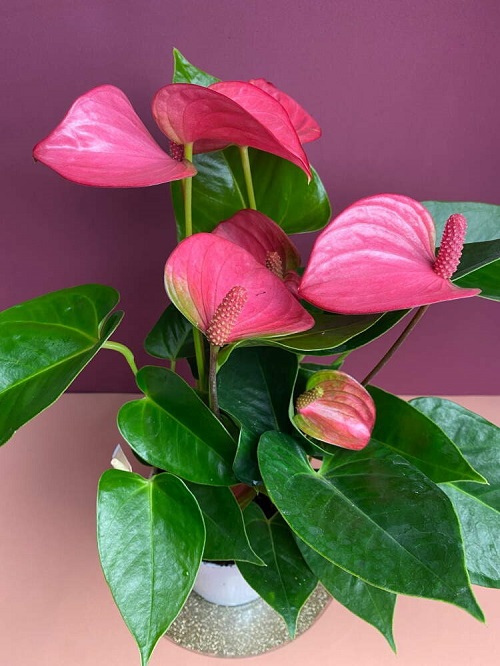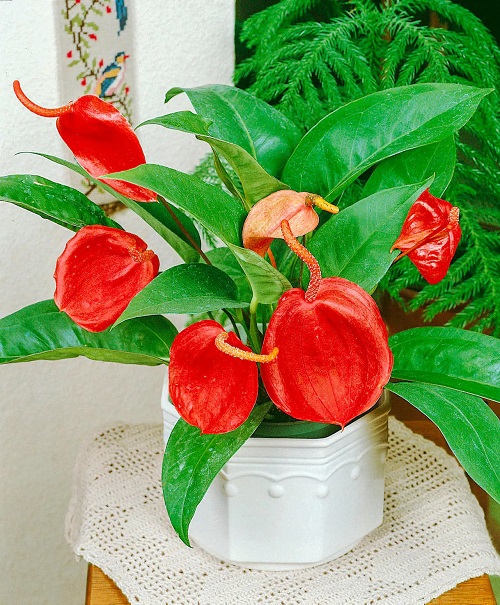Want to know the secrets about How to Grow a Big Anthurium Plant? Keep on reading as we have put some amazing tricks on it!
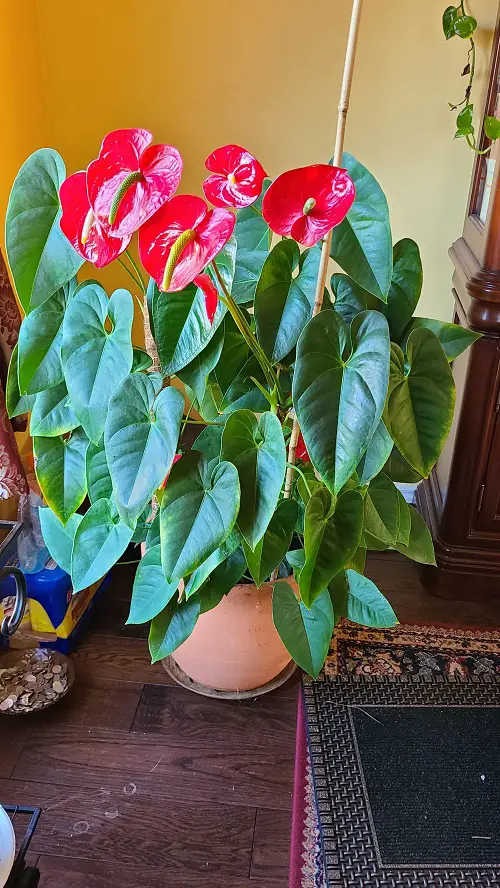
Red Anthuriums, with their heart-shaped, bold red spathes and dark green foliage, is the epitome of tropical charm. However, coaxing these plants to grow larger and more vibrant isn’t always straightforward. This guide lifts the curtain on some of the lesser-known specialist techniques used by master gardeners on How to Grow a Big Anthurium Plant!
Here’s everything about growing Anthurium Plants
How to Grow a Big Anthurium Plant
1. Selective Breeding
Start with a variety of Red Anthurium known for its size and vibrancy, such as Anthurium andraeanum or Anthurium ‘Red Champion’. These varieties have been selectively bred for their prominent red spathes and robust growth.
2. The Perfect Blend
A blend of one part perlite, one part peat moss, and one part orchid mix, mixed with a handful of charcoal, mimics the natural growing conditions of Red Anthuriums, promoting healthier and more vibrant growth.
3. Mimic Epiphytic Growth
Plant your anthurium in a well-ventilated orchid basket or mount it on a slab of cork bark. This mimics their epiphytic nature and can lead to larger, more vibrant plants by preventing root rot and promoting better air circulation.
4. Humidity Tactics
Use a humidity tray or a room humidifier to maintain high humidity levels. Some growers even go to the extent of creating mini indoor greenhouses specifically for their Anthuriums.
Light and shade balance ensures the plant receives bright, but indirect sunlight. However, commercial growers often expose their plants to one to two hours of direct morning sunlight to intensify the red color of the spathes.
5. Temperature Swings
Imitate the natural habitat by maintaining a day temperature of around 78-85°F (25-29°C) and dropping it to 65-70°F (18-21°C) during the night. This shift can encourage vibrant coloration and robust growth.
6. Feed Smartly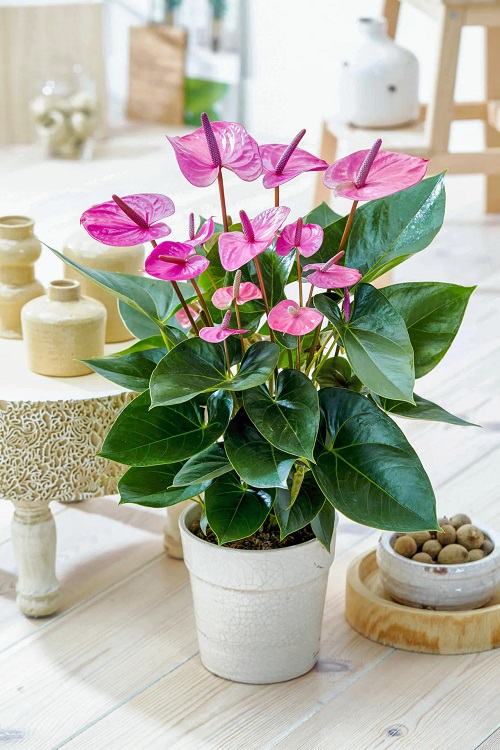
Use a high-phosphorus, water-soluble fertilizer during the growing season to promote brighter, bigger blooms. Additionally, once in six months, supplement with a slow-release, balanced granular fertilizer to ensure continuous feeding.
7. Strategic Pruning
Regularly prune older, yellowing leaves and spent flowers. This directs the plant’s energy towards producing larger, more vibrant spathes.
8. Propagation Perfection
Propagating from top cuttings (which include a piece of the stem and a couple of leaves) usually results in larger, more vigorous Red Anthuriums compared to propagation from root divisions.
9. Disease Prevention
Anthuriums are susceptible to certain pests and diseases, such as anthracnose and bacterial blight, which can affect their growth.
Inspect plants regularly, keep the foliage dry, and ensure good air circulation to prevent these issues.
10. Embrace Root Binding
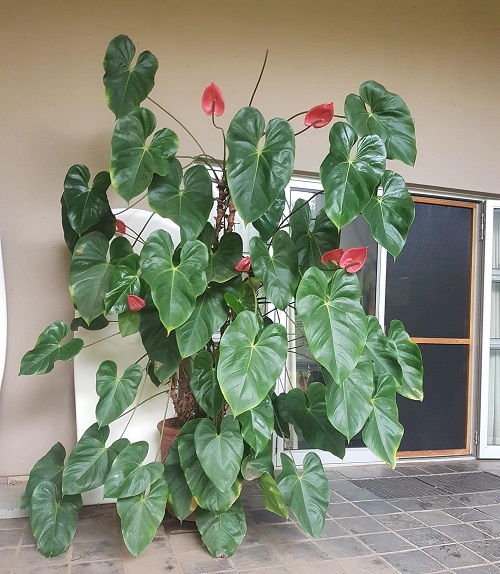
Unlike many plants, anthuriums prefer being slightly root-bound. Allow the roots to fill the pot before considering repotting, as this technique encourages the plant to produce more of its distinctive, red, heart-shaped spathes.
11. Aged is Gold
Let your Anthurium mature. Over time, with the right care, older plants tend to grow larger and taller. While the temptation to propagate might be high, remember that patience can yield a spectacular, towering plant.
12. Elevated Potting Strategy
Try the unusual technique of repotting in a slightly deeper pot, with the plant situated a little lower than it was previously.
This encourages the production of aerial roots from the stem, which, when they reach the soil, will contribute to the plant’s overall vigor and height.
13. Grow Lights
Consider the use of grow lights during darker months. By mimicking the tropical sunlight of the plant’s native environment, you can encourage continuous vigorous growth.
Armed with these tips, your journey to cultivate a taller, more majestic Red Anthurium can kickstart. These unusual techniques are the secret weapons that will set your plant apart, transforming it into a towering spectacle of tropical charm.
14. Smart Pruning
Instead of only pruning older, yellowing leaves, occasionally pinch out the growing tips on younger plants. This practice stimulates the plant to produce new growth lower on the stem, resulting in a taller, fuller plant.
15. Root Boosting
When repotting, consider adding a natural root stimulator to the potting mix. Products containing mycorrhizal fungi can stimulate root development and support taller growth.
16. Fertilizer Mix
Along with a high-phosphorus, water-soluble fertilizer, occasionally incorporate a seaweed-based supplement into your feeding regime. Seaweed extracts are known to promote root development, enhance uptake of nutrients, and support overall plant growth.
17. Inducing Stress
Introduce periods of mild stress by letting the plant dry out a bit between waterings. Like many plants, a small amount of stress can stimulate a growth response in Anthuriums.
18. Disease Defense
Regular inspections and preventative measures against common diseases are key. A taller plant will have more foliage and can be more susceptible to fungal diseases. Foliage should be kept dry, and the plant placed in a well-ventilated area.
19. Stem Support
As your anthurium grows taller, provide a moss pole or bamboo stake for support. This won’t directly make your plant taller, but it will support taller growth and prevent the plant from drooping or falling over.
Learn about Growing Anthurium Regale here
Big Anthurium Plant – FAQs
1. How long do anthurium plants live?
Anthurium plants, with proper care, can live for several years. In optimal conditions, they can thrive for as long as 5 to 10 years or even more.
Their lifespan depends significantly on factors such as proper watering, light conditions, humidity, and protection from pests and diseases.
2. How big do anthuriums get?
The size of an anthurium plant depends on its species, as the genus Anthurium comprises a wide range of plants. However, most common houseplant varieties of anthuriums, like the flamingo flower (Anthurium andraeanum), typically grow to about 1-2 feet tall and wide.
There are larger species in natural habitats that can grow taller, with leaves several feet long. In general, with good care and depending on the variety, an anthurium can grow substantial broad leaves and maintain a lush appearance.


